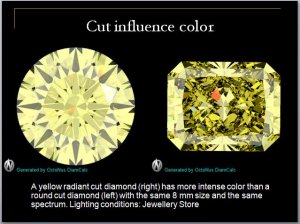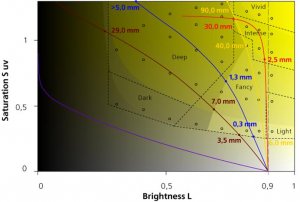- Joined
- Oct 21, 2004
- Messages
- 5,096
I know I am stepping on some toes here..., but lets dissect this grade called fancy light yellow....
Colored Diamonds are graded (by the GIA) from face up view..., I keep thinking who (professionals or consumers) does this grade really serve?!?!?
My opinion for a Diamond to earn its "Fancy color" grade..., it needs to possess a genuine body-color intensity.
I guess my question is the following...., If we take Diamonds which GIA graded fancy ''light'' yellow based on face-up appearance and re-issue these Diamonds for grading, but this time we include common color grading (table down/profile view) what are the graders going to conclude....?
Its no secret that Diamond cutters specializing in fancy-colored Diamonds take yellow shaded Diamonds and apply a cutting technique (mostly in the pavilion brillianteer) so the face-up appearance shows an even spreadiness of color..., but are these really Fancy colored Diamonds? GIA seems to think they are..., but is the consumers really getting what they are hoping to get? Or are they getting "modified Cape''s"??
I guess we could compare FLY to SI3 grades...
FLY is the grade in-between the less-valuable yellow and the yellow which starts to command premiums...
SI3 is the grade in-between the Included grade and the Slightly Included grade.
Sometimes I just wonder why GIA adapted the FLY grade and not SI3 grade?
Colored Diamonds are graded (by the GIA) from face up view..., I keep thinking who (professionals or consumers) does this grade really serve?!?!?
My opinion for a Diamond to earn its "Fancy color" grade..., it needs to possess a genuine body-color intensity.
I guess my question is the following...., If we take Diamonds which GIA graded fancy ''light'' yellow based on face-up appearance and re-issue these Diamonds for grading, but this time we include common color grading (table down/profile view) what are the graders going to conclude....?
Its no secret that Diamond cutters specializing in fancy-colored Diamonds take yellow shaded Diamonds and apply a cutting technique (mostly in the pavilion brillianteer) so the face-up appearance shows an even spreadiness of color..., but are these really Fancy colored Diamonds? GIA seems to think they are..., but is the consumers really getting what they are hoping to get? Or are they getting "modified Cape''s"??
I guess we could compare FLY to SI3 grades...
FLY is the grade in-between the less-valuable yellow and the yellow which starts to command premiums...
SI3 is the grade in-between the Included grade and the Slightly Included grade.
Sometimes I just wonder why GIA adapted the FLY grade and not SI3 grade?

























300x240.png)